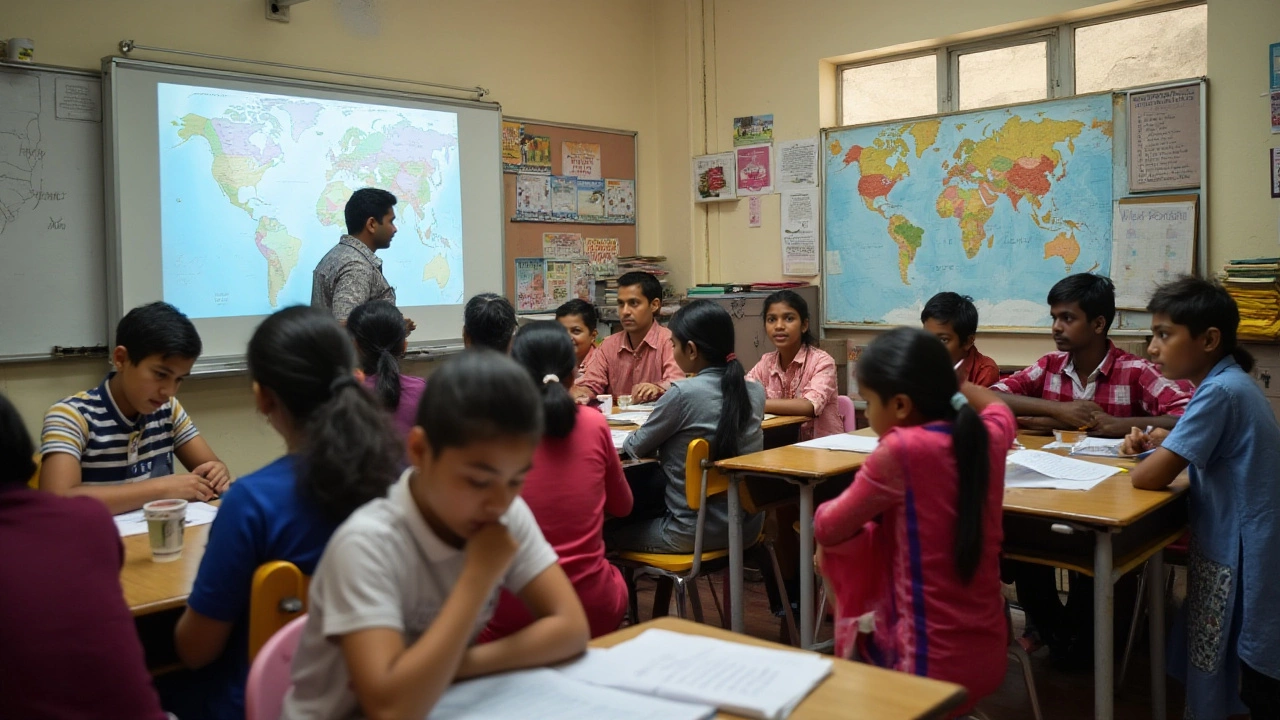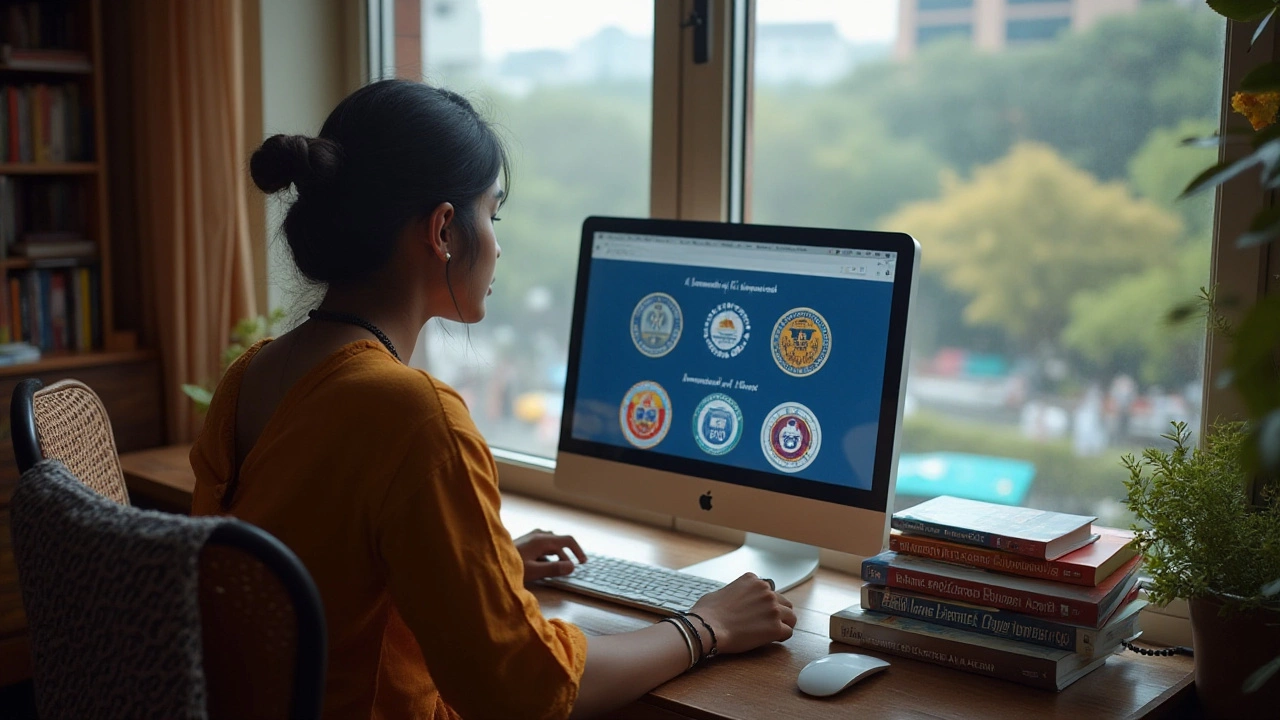Gazing across oceans for educational opportunities is an audacious step many Indian students take. However, when preparing for higher studies in the United States, a perennial question looms large – is a three-year undergraduate degree from India recognized by American institutions? This query holds the dreams and futures of numerous aspirants.
The U.S., with its dynamic academic landscape, often evaluates degrees based on certain criteria, creating a patchwork of acceptance that varies from one university to another. While some institutions accept these degrees as equivalent, others might require additional coursework. Navigating this landscape involves not just an understanding of one's own educational background but also an insight into the U.S. education system.
- Understanding the Indian 3-Year Degree
- How U.S. Institutions Evaluate Foreign Degrees
- Accreditation and Its Importance
- Challenges Faced by Indian Students
- Navigating the Admission Process
- Tips for Enhancing Degree Recognition
Understanding the Indian 3-Year Degree
Diving into the essence of an Indian 3-Year Degree uncovers an education path that combines rich tradition with modern adaptations. Originating primarily in the arts, commerce, and science streams, this undergraduate program is prevalent across Indian universities. Despite its shorter duration compared to the usual global norm of four years, the curriculum is intensive and comprehensive, catering to a diverse range of academic interests. In India, the three-year degree holds equal esteem and paves a standard route for venturing into various professional fields or further studies within the country.
Unlike the American system, which leans heavily towards a broad-based education during the undergraduate years, Indian universities often emphasize depth in a chosen field. This specialization approach is seen in the meticulous course designs that require students to immerse themselves more fully into their selected disciplines from the outset. A typical course outline might include core subjects, electives to broaden knowledge horizons, and practical applications to build real-world skills. This schooling reflects the education system's ability to equip students with an intense foundation in specific domains.
Notably, the success of students from a three-year degree background, both domestically and internationally, substantiates the quality and rigour embedded in these programs. Many top achievers in various fields have emerged from this system, and the degree remains a respected and viable educational qualification. In a recent study conducted by the All India Survey on Higher Education (AISHE), over 60% of Indian graduates annually are products of this three-year structure, underscoring its widespread reach and acceptance.
That said, the international recognition of the degree often hinges on how the receiving institution perceives the curriculum and its equivalence to their own. A spokesperson from a leading Indian university once summarized the scenario succinctly in an academic forum: "Our degrees are like compressed stars – they might look smaller, but they pack immense academic strength."
The challenge, however, lies with the perception gap that exits overseas where duration sometimes outweighs content quality in decision-making.Addressing this perception and ensuring an effective evaluation process is crucial for students aiming to cross educational frontiers.
To bridge the gap between these systems, various Indian universities have sought accreditation from globally recognized academic bodies, which plays a vital role in fortifying their position on the educational landscape. Accreditation can enhance the degree's acceptability abroad, making it easier for graduates to pursue opportunities without extensive bureaucratic hindrances. This strategic move aids in leveling the playing field where the Indian degree encounters various international educational benchmarks, especially in the US acceptance realm. Such developments not only elevate the institution's profile but also provide graduates with brighter prospects on the global stage.
How U.S. Institutions Evaluate Foreign Degrees
When it comes to assessing foreign degrees, U.S. institutions deploy a variety of methods to ascertain compatibility with their educational systems. These methods aren't mysterious, but they do require an understanding of the nuances of credential evaluation. At the heart of it lies the concept of accreditation, which becomes pivotal when deciding whether an Indian 3-year degree is equivalent to a U.S. bachelor's degree. Educational credential evaluators play a key role here, acting as the bridge between different academic worlds. Their task involves assessing whether the academic depth and breadth of foreign degrees align with U.S. academic standards. This process is critical for universities when considering international students for graduate programs.
Take, for example, World Education Services (WES), one of the leading credential evaluators in the United States. They typically scrutinize the course content, the institution's accreditation, and the specific program's structure when evaluating degrees. A significant factor in their assessment is the credit hour system. Many U.S. institutions rely on this to measure whether the academic workload is comparable. For instance, a three-year bachelor's degree from an accredited institution in India is often considered equivalent to a U.S. degree with 120 credit hours. This assessment, however, can vary as each university may set its own criteria.
There's also a growing recognition of the diversity in global education systems. As more international students aspire to study in the U.S., universities adapt by implementing more flexible evaluation criteria. A spokesperson from the American Council on Education once remarked, "Understanding the global context of educational qualifications is essential in a world where learning transcends borders." However, students must remember that while some programs might accept a three-year degree without much hassle, others, especially in specialized fields, may require additional courses or a conversion master's.
Another critical piece of the puzzle is institutional partnerships. Universities with strong ties to Indian institutions may offer more lenient evaluations, acknowledging the rigorous education systems in place there. These partnerships often result in tailored pathways for students wishing to pursue higher studies in the U.S., adding layers of opportunity and ease to the transition. It is crucial for students to explore these alliances and understand the potential benefits.
For students and graduates holding an Indian degree, an effective strategy is to gather detailed documentation of their academic achievements and syllabi. This portfolio becomes invaluable during evaluations, offering insights into the depth of their education. Engagement with education fairs and counseling sessions can offer personalized guidance tailored to specific university requirements. By preparing extensively and understanding how evaluations work, students can significantly ease their transitions into their chosen programs, paving the way for a successful academic journey in the United States.

Accreditation and Its Importance
Accreditation acts as a seal of approval from educational bodies, affirming that an institution or a specific program meets established standards of quality. When it comes to degrees from India, especially the widely pursued Indian degree, the role of accreditation cannot be overstated. The recognition of a degree often hinges on whether the issuing institution is accredited by recognized bodies, both within India and in the international academic community.
Understanding the nuances of accreditation begins with grasping its core benefits. Primarily, accreditation serves as a quality control mechanism, ensuring that institutions uphold educational rigor and provide a sound learning environment. In India, universities are accredited by entities like the University Grants Commission (UGC) and the National Board of Accreditation (NBA). These bodies evaluate institutions based on criteria such as faculty qualifications, curriculum design, student support services, and infrastructure.
For those aspiring to study in the United States, knowing that your Indian institution is accredited by these organizations is crucial. U.S. universities often refer to these local accreditations to gauge the credibility of the international students' previous education. They rely heavily on the assessment done by legitimate bodies in the student's country. However, each U.S. institution may have its own yardstick for evaluating foreign degrees, sometimes requiring a credential evaluation report from agencies like World Education Services (WES). This report helps translate the foreign academic credentials into U.S.-comparable standards.
A 2019 report from the American Association of Collegiate Registrars and Admissions Officers (AACRAO) indicates that nearly 90% of U.S. institutions consider the accreditation of a student's home university when deciding on admissions.
"Accreditation ensures that the education provided by institutions of higher education meets acceptable levels of quality," noted AACRAO's senior director in a webinar discussing international education trends.This insight is valuable for Indian students seeking to align their academic achievements with the expectations of U.S. universities.
Furthermore, accreditation plays a pivotal role in career opportunities. Employers, much like higher education institutions, regard accredited qualifications more favorably. Accreditation assures them that the prospective employee has received instruction meeting consistent academic standards. For higher education seekers, it translates to better eligibility for financial aid, smoother transfer of credits, and greater acceptance by postgraduate programs.
As the global education landscape becomes increasingly competitive, students from India holding a 3-year degree should leverage accreditation not only as a proof of quality but as a strategic asset. By selecting accredited programs, students pave a smoother path for their future educational and professional endeavors. Recognizing the variable responses from U.S. institutions, Indian degree holders are encouraged to do thorough research ahead of applications and consider obtaining independent evaluations to bolster their admission prospects.
Challenges Faced by Indian Students
Setting sail to the United States for academic pursuits is no small feat for Indian students, particularly when armed with a three-year degree. The most formidable hurdle is the lack of a standardized recognition mechanism across U.S. universities. Some institutions greet these degrees warmly, while others cast a degree of skepticism, viewing them as not on par with the American four-year system. This discrepancy often leaves students in a gray area, unsure about how to position their credentials in admissions applications. It is, therefore, essential to communicate clearly with potential universities about their specific requirements and flexibility regarding Indian degrees.
Another considerable obstacle is navigating the unfamiliar and often convoluted application processes of each university. Adding to this complexity is the requirement for supplementary qualifications. Many students find themselves compelled to undertake additional coursework or enroll in bridge programs to reach parity with their American counterparts. This can be daunting due to the time, money, and effort needed to complete these extra requirements. It’s crucial to thoroughly research each institution’s policies and perhaps choose those institutions with a history or policy of accepting Indian degrees.
Beyond logistical hurdles, students also encounter cultural and academic differences that can impact their transition. Moving from a rote-learning system prevalent in India to a more research-oriented and critical-thinking-based education model in the U.S. could pose a challenge. Adapting to this new learning approach requires time and willingness to embrace a different educational framework. Moreover, social integration into a diverse environment presents an additional layer of complexity. Forming support networks on campus and engaging with international student bodies can ease this transition substantially.
Financial considerations are omnipresent, especially given the significant investment in U.S. education. Scholarships specifically targeted at international students can be scarce, making it imperative to scout for monetary aids early. Obtaining a part-time job may provide a financial cushion, yet juggling work and studies demands excellent time management skills.
An often overlooked challenge is the emotional toll that moving across continents can bear on students. Homesickness is not uncommon, compounded by the pressure of academic performance and cultural assimilation. Establishing connections through social media or student organisations with fellow Indian students can mitigate feelings of isolation.
The Institute of International Education notes, "The number of Indian students in the U.S. has seen a steady increase, showcasing the value placed by Indian students on U.S. education despite the myriad challenges faced."
Simplifying the acceptance process of a three-year degree involves a multi-pronged approach. Universities must have clear, transparent policies regarding foreign degrees, while students should remain proactive, seeking guidance and establishing communication with admissions offices. This partnership can bridge gaps and facilitate a smoother transition. Resources such as educational consultants experienced in navigating cross-country degree acceptance can also prove invaluable in this journey.

Navigating the Admission Process
When contemplating studies in the United States, it's crucial for holders of an Indian degree to decode the admission process with precision. Initiating the journey requires an exhaustive exploration of U.S. institutions to ensure that your specific academic credentials align with their expectations. Each university often has its academic evaluation criteria. Therefore, it becomes vital to research each prospective institution's stance on international degrees. Many American universities have dedicated International Student Offices, where you can obtain comprehensive guidance tailored specifically for students with a three-year Indian degree.
Applying to U.S. universities with an undergraduate degree from India means familiarizing yourself with terms like 'credit equivalency' and understanding your degree's evaluation through established credential evaluation services. Agencies such as World Education Services (WES) offer detailed assessments that many universities trust. In fact, a few require evaluations before admission decisions. This highlights the importance of having your academic transcripts in pristine condition, as these evaluations largely rely on the authenticity and clarity of your educational records.
Once you have narrowed down potential universities, it's time to prepare for standardized testing, a cornerstone of the U.S. admission process. Tests like the GRE, TOEFL, or IELTS are almost a universal requirement, helping institutions assess your readiness for graduate-level studies and English proficiency. Scoring well in these can balance concerns about the three-year degree's perceived rigor.
"Standardized tests play an important role in admissions, as they provide a common measure for all applicants," notes an admissions officer from a renowned U.S. university.It's important to strategize your test preparation well in advance, aiming not just to meet but exceed the minimum score requirements, to strengthen your application.
Crafting a compelling personal statement or statement of purpose also becomes a critical component of your application packet. This document allows you to explain your academic journey, emphasizing your accomplishments and aspirations. It's an opportunity to address how your Indian degree has equipped you with unique skills or perspectives that would benefit the university community. Your narrative should also reflect an understanding of your chosen field of study and how it aligns with the university's offerings.
Finally, securing strong letters of recommendation cannot be overstated. They serve not only as endorsements of your past work but also as testimonials to your potential as a student in a U.S. academic setting. Reach out to professors or professionals with whom you've closely worked, detailing the specific aspects of your capabilities or achievements they could mention. With these elements perfectly aligned, your application will present a convincing case for admission, proving that an Indian degree can indeed pave the way for success in the U.S.
Tips for Enhancing Degree Recognition
Getting your Indian degree recognized in the US can be a daunting process, but strategic steps can ease the journey. One of the foremost actions is ensuring your degree comes from an accredited institution. Accreditation is a rigorous independent evaluation that assesses the quality and standards of educational processes and outcomes. This serves as a mark of quality for your degree and can significantly enhance its acceptance by American universities. Listing your institution’s accreditation on your credential evaluation reports often paints your academic background in a favorable light.
Another useful approach is pursuing additional coursework through bridge programs offered by some US universities specifically for international students. These programs help to bolster the curriculum content that might be lacking in a 3-year Indian degree compared to the four-year American equivalent. By completing such courses, students not only fill the credit gap but also get accustomed to the American education format, which often emphasizes critical thinking and discussion-based learning.
According to a report by the Institute of International Education, "Institutions seek students who are adaptable, self-driven, and have an education that aligns closely with their program offerings."
Additionally, having comprehensive documentation of your coursework, including detailed syllabi, can immensely support your case. Providing precise information about your completed courses enables evaluators to compare them precisely with US standards. It's akin to giving a glimpse into the depth and breadth of your academic journey, displaying not just the subjects studied but also the intensity and relevance of each.
Beyond academic strategies, harnessing personal and professional networks holds tangible benefits. Alumni connections to your prospective schools can offer firsthand insights and influence admission decisions positively. Furthermore, reaching out to international student offices at these institutions aids in demystifying application procedures, as they have experience guiding students with foreign academic backgrounds.
Be Proactive and Stay Informed
Staying updated with the specific requirements and policies of each university is crucial. With an ever-evolving academic landscape, policies may differ tremendously from one institution to another. Regularly checking admission guidelines and communicating with admissions officers ensures that you possess the current and correct information. This proactive stance demonstrates your serious commitment and keenness in aligning your educational background with their expectations.
| Year | Number of Indian Students in the US |
|---|---|
| 2020 | 193,124 |
| 2021 | 199,182 |
| 2022 | 211,932 |
Numbers have shown a steady increase in the flow of students from India to the US, reflecting the resilience and adaptable approaches many have successfully employed. As these statistics reflect an upward trend, they are testament to the meaningful strategies that can lead to successful acceptance and integration into American academia for holders of an Indian 3-year degree.
